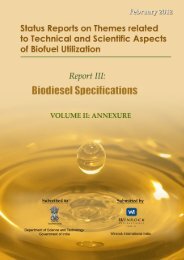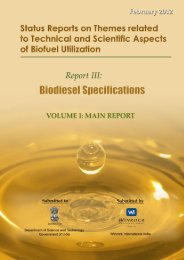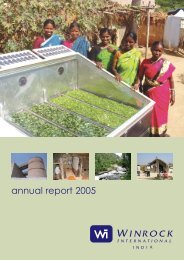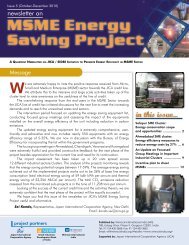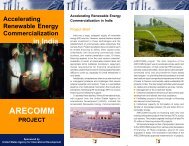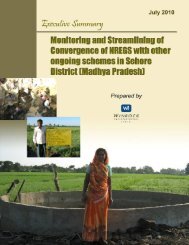IssuE 8 â ApRIl â JuNE 2011 - Winrock International India
IssuE 8 â ApRIl â JuNE 2011 - Winrock International India
IssuE 8 â ApRIl â JuNE 2011 - Winrock International India
Create successful ePaper yourself
Turn your PDF publications into a flip-book with our unique Google optimized e-Paper software.
Bioenergy for Himalayas<br />
the size the greater would be the utility<br />
for a stand alone system. Tiny hamlets<br />
are also more likely to be remote thus<br />
according defacto additional weight to<br />
the remoteness.<br />
Third attribute is the land availability<br />
and the attribute parameter chosen is<br />
the sufficiency of the available land<br />
for meeting the biomass demand<br />
for energy production. If the land<br />
available at a site is much more than<br />
required for meeting the biomass<br />
demand then it is most suitable.<br />
This would mean that no land fit<br />
for agriculture would be put under<br />
bioenergy production thus reinforcing<br />
the food security requirement which<br />
is also dealt separately. Further a<br />
site with much higher extent of<br />
land availability is also likely to be<br />
remote and thus this requirement is<br />
also further likely to strengthen the<br />
remoteness requirement.<br />
Next attribute is the landslide control<br />
with severity of the landslides taken<br />
as the attribute parameter. With an<br />
appropriate harvesting mechanism<br />
undertaken in a sustainable manner<br />
tree growing for energy would play a<br />
positive role in landslide control and<br />
hence the most landslide prone lands<br />
are considered the best choices for<br />
biomass growing for energy.<br />
Next attribute is the moisture<br />
conservation and the amount of rainfall<br />
and number of rainy days are taken<br />
as twin parameters. The sites with the<br />
least rainfall occurring over the shortest<br />
span are considered most suitable as<br />
the trees raised for biomass generation<br />
on such lands would provide the<br />
highest positive externality in so far as<br />
moisture conservation is concerned.<br />
Another attribute is the energy<br />
security with the amount of energy<br />
available from other sources in terms<br />
of fulfilling the requirement as the<br />
attribute parameter. The site that has<br />
the least availability of energy from<br />
other sources would score the highest<br />
on this scale since the objective is to<br />
enhance the energy security of the<br />
communities.<br />
Yet another attribute is the food<br />
security where the attribute parameter<br />
is the extent of agriculture land that<br />
is used for raising trees for biomass<br />
generation and carries negative<br />
weight. Food security concerns have<br />
been given high weight and sites,<br />
where more than a quarter of the<br />
available agriculture lands would<br />
have to be used for meeting the tree<br />
bioenergy needs, are awarded the<br />
highest negative weight. The most<br />
preferred are the sites where no<br />
agriculture lands are diverted for<br />
raising biomass for energy.<br />
Another attribute is the wildlife<br />
conservation having one negative and<br />
one positive attribute parameter. The<br />
negative attribute parameter operates<br />
in sites where the keystone wildlife<br />
species requires a grassland habitat<br />
as is the case in many high altitude<br />
Himalayan areas which are suitable<br />
habitats for the rare Tibetan antelope.<br />
This is because tree raising for biomass<br />
could lead to reduction of grassland<br />
habitats. Highest negative ranking is<br />
accorded to sites where raising trees<br />
for biomass would reduce more than<br />
a quarter of the community landscape<br />
suitable for such a keystone species.<br />
The positive attribute parameter<br />
becomes operational if tree raising<br />
for biomass increases the habitat<br />
of a keystone species for wildlife<br />
conservation and the highest ranking<br />
is awarded where the increase in<br />
habitat is more than 75% within the<br />
community landscape.<br />
Yet another attribute with negative<br />
dimensions is the economic security<br />
of the local resource poor people<br />
dependent upon the NTFP for<br />
livelihood requirements. Tree planting<br />
for biomass has the potential of<br />
reducing the income of these people<br />
significantly. Just like in the case of<br />
the other two negative externalities<br />
in this case also high weight has been<br />
accorded to the loss of income from<br />
NTFP to the poor community and a<br />
25% decrease in such income would<br />
result in the maximum negative<br />
valuation.<br />
Soil conservation is another positive<br />
externality of tree planting for<br />
biomass. For the sake of ease only one<br />
attribute, namely, steepness of slope<br />
has been taken as attribute parameter<br />
and the higher the slope the higher is<br />
expected to be the benefits from tree<br />
planting and slope in excess of 75%<br />
is awarded the highest ranking. It is,<br />
ofcourse, presumed that bio-energy<br />
harvesting would be sustainable.<br />
Biodiversity conservation is also an<br />
important attribute with the extent of<br />
restoration of the original habitat taken<br />
as attribute parameter. Highest rank is<br />
accorded when the biomass generation<br />
is expected to lead to restoration of<br />
more than 75% of the native fauna.<br />
Discussion and Conclusions<br />
All the possible sites are than ranked<br />
against each attribute parameter by<br />
a well trained peer group along with<br />
well informed local stakeholders.<br />
The total of all attribute parameters<br />
for each site would give its score<br />
and those with higher scores would<br />
constitute priority that would help<br />
optimize economic, ecological and<br />
social benefits through appropriate site<br />
locations.<br />
April-June <strong>2011</strong><br />
17




